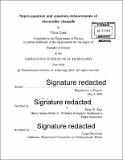Super-quantum and quantum enhancements of two-sender channels
Author(s)
Quek, Yihui
DownloadFull printable version (4.362Mb)
Other Contributors
Massachusetts Institute of Technology. Department of Physics.
Advisor
Peter W. Shor.
Terms of use
Metadata
Show full item recordAbstract
This thesis studies the consequences of 'super-quantum non-local correlations', which are hypothetical violations of Bell/CHSH inequalities that are stronger - more nonlocal - than quantum mechanics allows, yet weak enough to respect special relativity in prohibiting faster-than-light communication. Understanding the power of such correlations will yield insight into the non-locality of quantum mechanics. Whereas previous studies of super-quantum correlations have demonstrated enhancements in cryptography and computation of distributed functions, this work opens up a new direction of research by showing that they can also enhance the capacity of classical communication over a noisy channel. Our results exhibit a trifecta of proof-of-concept channels: first, we show an interference channel between two sender-receiver pairs where the senders are not allowed to communicate, for which a shared super-quantum bit allows perfect classical communication. This feat is not achievable with the best classical (senders share no resources) or quantum-assisted (senders share entanglement) strategies. We next show two examples that are conjectured to demonstrate the following capacity separations: an interference channel that strictly separates super-quantum from quantum-assisted strategies, and quantum-assisted from classical strategies; and, lastly, a multiple-access channel that strictly separates super-quantum- assisted strategies from classical ones. At the heart of some of these examples is a novel connection between multi-sender channels and multi-player XOR and pseudo-telepathy games.
Description
Thesis: S.B., Massachusetts Institute of Technology, Department of Physics, 2016. Cataloged from PDF version of thesis. Includes bibliographical references (pages 67-70).
Date issued
2016Department
Massachusetts Institute of Technology. Department of PhysicsPublisher
Massachusetts Institute of Technology
Keywords
Physics.